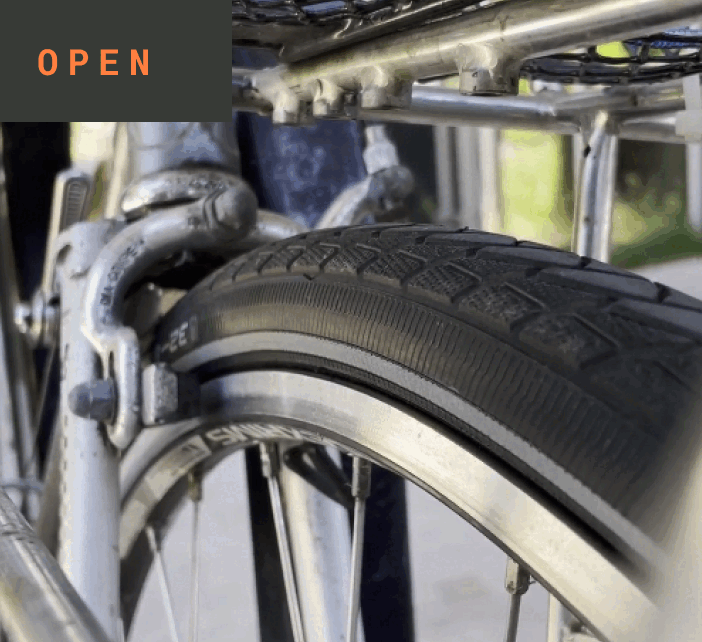Let's Modo
Published: February 1, 2023
The ABC’s of Bike Safety
Get Ride-Ready with this Quick Safety Check
Bike safety covers a lot of territory. We could be talking about safe riding, traffic safety, helmets, nighttime visibility, or lights. In this article, though, we’re going to cover a few basics you should check before every ride.
The ABC Quick Check is an easy-to-remember pre-ride checklist to help you make sure your bike is safe and ready to go, whether it’s down the street to the store, commuting to work, riding with friends, or any other cycling trip! Let’s jump in!
‘A’ is for Air
The last thing you want is a flat or low tire on your ride. All tires have a range of proper inflation for best performance. The first step is giving your tire a squeeze test. If your tire is soft or gives in, it’s time to pump it up! Most tires that are designed for riding on pavement only work when firm, the exception being mountain bike or gravel tires, which can be ridden with lower pressure to increase traction in dirt settings. If you have a pump with a pressure gauge, use it to inflate your tires to within the recommended range. If you don’t have a pressure gauge, no worries: just pump up your tires and do the squeeze test until they are firm. While you’re down there, it’s also a good time to check for any tire damage.

‘B’ is for Brakes
Let’s make sure that you can stop quickly if you need to. There are a couple of ways to check your brakes. First, the rule of thumb is to give your brakes a squeeze and check that the brake lever is stopping before you reach your handlebar. If the lever comes all the way back to your handlebar, you are likely working with brakes that are worn and/or a brake cable that is stretched. This is a clear sign that you should not ride and that your brakes need to be replaced. When you squeeze the handbrake, make sure your brakes stop with enough space to fit your thumb between your lever and the handlebar to ensure full braking ability. Now, check to see if your rim or disc brake pads are landing on the brake surface (either the rim of a wheel or a disc brake rotor). If your pads are maladjusted, you could experience decreased braking power, asymmetrical wear on your pads, rubbing, or, in the worst-case scenario, brake failure. During wet conditions, it’s especially important to check your brake pads and make sure they are good to go.


‘C’ is for Cranks, Chain, and Cassette
The Triple C! When it comes to checking your cranks, chain, and cassette, you first need to visually inspect them to make sure the metal is clean and not bright orange with rust or black and brown with grease and road gunk. Then, spin your cranks backward to make sure your chain is freely moving through your gears. If you see or hear clicking noises or your chain gets stuck, you’ll need to look further and free your chain. Sometimes, a quick wipe down and lubrication can go a long way toward preventing chain woes and getting you pedaling again.
‘Quick’ is for Quick Releases
Make sure your wheels don’t fall off during your ride! For bikes with quick releases, check to make sure the release latches are closed and securely tightened. Quick releases are commonly found on your wheels and seat post for easy wheel removal or seat height adjustment. Pro Tip: Never lock your bike in these places for this reason. A quick release axle has a rod with a lever on one side and a nut on the other, and it allows you to remove the wheel of your bicycle without a tool. A quick release axle also allows you to remove the wheel without removing the axle. The axle will stay inserted into the hub. A loose quick-release is dangerous because these mechanisms hold the wheels in place. The most common mistake is simply turning the lever like a nut until the wheel seems tight. If you tighten it this way, the nut can loosen over time and potentially lead to a wheel becoming dislodged, causing a catastrophic bike accident. Yikes! You want to apply a good amount of force to close the quick release, but not so much that you need to put your whole body into it. Some quick release levers also say “open” or “closed” on either side of the lever to make it easier to secure them correctly.

‘Check’ is for Check It All Over
Time to give it all a test! Once you have gone through the ABC and Quick checks, we recommend riding your bike around a safe place to make sure the elements are working together. When you’ve completed your final check, you’re ready to ride! When you regularly do the ABC Quick Check before every ride, you can go through the whole process in under a minute – and just like that, you’re on your way to safe riding!
